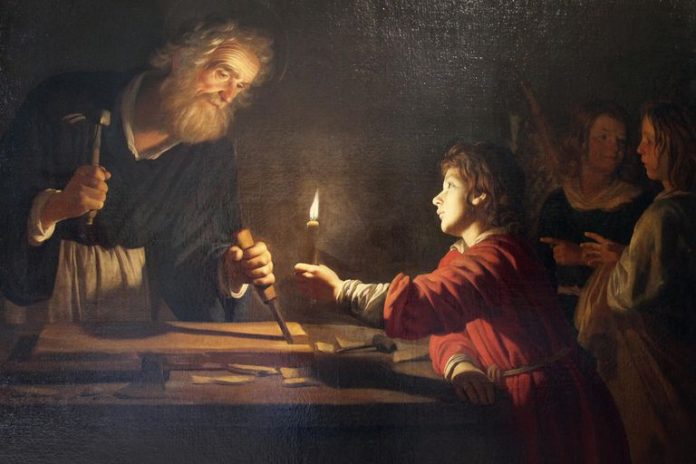A quality that has defined my ten years of priesthood and most of my life is a consistent and deep devotion to St. Joseph. Therefore, I was intrigued to read Joshua Filipetto’s article, St. Joseph’s Perpetual Virginity and the Apocrypha, which made me question some of my opinions regarding St. Joseph. The phrase “the perpetual Virginity of St. Joseph” is not one that I recall ever having read before, let alone considered that I must “piously believe in [it]”, so I spent a few hours reading Mr. Filipetto’s sources and a few other documents on Joseph to see whether my opinions need reform. On both his assertion of the perpetual virginity of Joseph and his dismissal of “apocrypha” I think Mr. Filipetto overstates his case and draws hasty conclusions; however, both assertions have value and are worth further consideration. In this article I will first discuss Mr. Filipetto’s conclusions regarding “apocrypha” and then the perpetual virginity of Joseph.
To begin, I will confess that I quite like the Protoevangelium of James. Granted, it is not Scripture, and it should not be treated as such. The condemnation of “apocrypha” made by Pope St. Innocent I, referenced by Mr. Filipetto, needs some qualification. His statement is from a letter to the Bishop of Toulouse in which he is clarifying which books constitute the Canon of Scripture. This source is not a canon of a council or synod. Nor is it an encyclical or a papal bull. It is a letter to an individual bishop who has presumably written to the pope asking for help with teaching his flock what is Scripture and what is not. Innocent does not use the word “apocrypha” but rather lists several books that have been attributed to Apostles, one of which may refer to the Protoevangelium of James. He says, “They are not only to be rejected but also condemned.” From this statement it is not clear whether he is only condemning their inclusion in the Canon or the entirety of their content. His statement is cause for caution in approaching the various ancient texts falsely attributed to Apostles, but it cannot be taken as a universal and permanent condemnation of every work classified as “apocrypha”.
Not all apocrypha are created equal. Remember that most Protestants consider several books in the Catholic Canon to be apocrypha. Literally meaning private or hidden, apocrypha is a word that has negative connotations because of its association with forbidden books, but it can be taken in the more general sense of “non-canonical” and thus for “private”, as opposed to “public”, use. In this general sense there are non-heretical apocrypha, such as the Epistle of Barnabas and the Didache, which were not included in the Canon but are clearly esteemed by many Church Fathers and considered works of the Apostolic Fathers. There are also heretical apocrypha, such as the Gospels of Thomas and Judas, that are Gnostic in origin and clearly false. The Protoevangelium of James is of ancient origin, dating to around the year 150 AD, and it does not contain heresy, but it does not hold the same esteem given to sources such as the Didache.
The value of the Protoevangelium of James is that it gives us a view into the popular piety of the early church regarding devotion to the Blessed Virgin and Joseph. The primary motive of the text is clearly to emphasize the perpetual virginity of Mary and to answer some common questions that any reader of the Gospels would have regarding her “hidden” life. Joseph’s depiction as an elderly widower entrusted with the Mary’s protection safeguards the doctrine of her Perpetual Virginity, and it gives an answer (granted, not the only answer) to why there are various references to the “brothers and sisters” of Jesus in the Gospels. The text even goes so far as to have a midwife miraculously punished for trying to physically determine Mary’s Virginity after Christ’s birth. In many respects the apocrypha are comparable to modern biblical historical fiction. At worst they are heretical nonsense that leads people astray and at best they are stories that help to reinforce dogma and give content for pious meditation. For further reflection on some of the dangers of this genre see the Editor’s article To Choose, or Not, ‘The Chosen’. The Protoevangelium of James is certainly not beyond criticism, but nearly 200 years before the great Post-Nicene Fathers began writing their defenses of Mary’s Perpetual Virginity, the Protoevangelium had already given expression to this fundamental Marian dogma.
Joseph is merely a supporting character in the Protoevangelium. Given his clear role in guarding the dogma of the Perpetual Virginity of Mary, it is easy to see why many authors dismiss this depiction of Joseph as having little historical value.[1] I won’t argue with that opinion; in fact, it supports the traditional view of Joseph, which is that the details of his hidden life aren’t important. He’s in the story to protect and provide for Mary and Jesus, so that they can accomplish their missions, and then he disappears.
Does the supporting role and disappearance of Joseph mean he isn’t important? Certainly not. In his acclaimed book The Mystery of Joseph, Fr. Marie-Dominique Philippe, OP speaks about the silent departure of Joseph from the Gospels. We are not told anything about Joseph after Jesus is twelve years old. Fr. Philippe says,
“On account of this silence some claim that he was taken up into Heaven. Yet we can interpret this silence in a different way and understand that it helps us to discover Joseph’s spiritual poverty—the poverty of this father who exercised so unique an authority and who is truly servant par excellence—the servant of the New Covenant, gentle and faithful but dispensable. Surely, is not the greatest legacy left to us by this dispensable servant the very fact that no trace remains of him?”[2]
The importance of Joseph’s dispensability leads into the discussion of the “Perpetual Virginity of St. Joseph.” Whether or not Joseph had been married prior to his marriage to the Blessed Virgin was not an important question to the Fathers of the Church because it has no bearing on the Divine origin of the child conceived in Mary’s womb. Joseph’s story begins when he is betrothed to Mary because that is when he becomes her protector and provider. From a theological perspective his virginity only matters in relation to her, which is why traditional texts don’t refer to him as a virgin, but rather as chaste or as having a “virginal” love for her. In his essay The Virginity of St. Joseph in the Latin Fathers and Medieval Ecclesiastical Writers, Florent Raymond Bilodeau asks, “What can be concluded from the evidence we have just presented on Saint Joseph’s virginity? Since there is no general tradition on this point in the Western Fathers, certainly no comprehensive argument can be drawn.”[3] The Fathers of the Church only discuss Joseph’s virginity insofar as it relates to Mary because we cannot understand Joseph in a way that would contradict our understanding of Mary. The Fathers were divided on whether Joseph was a widower because this theory offers an answer to the question of the brothers and sisters of Jesus, while not contradicting the Perpetual Virginity of Mary, but it adds complexity to Joseph’s story that does not have clear Biblical support.[4]
According to Bilodeau, the Western Medieval Ecclesiastical writers more clearly advocate for the perpetual virginity of Joseph.[5] Surveying commentary from Bede the Venerable, Albert the Great, Thomas Aquinas, and others, he proposes that their general position is that belief in Joseph’s perpetual virginity is fitting. There is no doubt that he was chaste in relation to Mary, that he was not a fornicator, and that he had always been a righteous man, but there is ambiguity regarding his perpetual virginity because their arguments are speculation on the “fittingness” of that claim. To say that Joseph was a widower does not deny his chastity, so it is not necessary to condemn this position, but due to lack of Biblical support there is also no reason to assert that he was a widower; therefore, it is praiseworthy to assert the perpetual virginity of Joseph. To say that we must “piously believe in [it]”, however, is not Bilodeau’s conclusion. Rather, he states, “We may safely say, with regard to Saint Joseph’s perpetual virginity, that today it would be rash to deny this doctrine or to speak against it. However, as Durand points out, not one theologian has ever claimed that this was a dogma of faith or even a doctrine that could be defined.”[6]
Even if I do choose to believe in the perpetual virginity of Joseph, which I am happy to do, there are still two questions that remain for me: was Joseph young or old when he married the Blessed Virgin and what is the value of describing Joseph as a “virgin”?
In the past century various authors have taken up the cause of promoting a ‘young Joseph’ as the Spouse of the Virgin Mary. Perhaps the most famous advocate of this position is Bishop Fulton Sheen. In his book The World’s First Love he dedicates a chapter to the spousal love of Mary and Joseph, and he gives a compelling argument for belief in a ‘young Joseph’. Sheen acknowledges that the consensus of the past, at least in sacred art and the Fathers, is that Joseph was elderly when he married the Blessed Virgin, but he argues this assumption is only for the sake protecting Mary’s Virginity.[7] I encourage you to read this whole chapter, but I will quote a portion that encapsulates his line of argumentation:
Joseph was probably a young man, strong, virile, athletic, handsome, chaste, and disciplined; the kind of man one sees sometimes shepherding sheep, or piloting a plane, or working at a carpenter’s bench. Instead of being a man incapable of loving, he must have been on fire with love. Just as we would give very little credit to the Blessed Mother if she had taken her vow of virginity after having been an old maid for fifty years, so neither could we give much credit to a Joseph who became her spouse because he was advanced in years. Young girls in those days, like Mary, took vows to love God uniquely, and so did young men, of whom Joseph was one so pre-eminent as to be called the “just.” Instead, then, of being dried fruit to be served on the table of the King, he was rather a blossom filled with promise and power. He was not in the evening of life but in its morning, bubbling over with energy, strength, and controlled passion.[8]
For Sheen, a young Joseph provides us with a more suitable icon of the masculine virtues that must be present in a holy spouse and father.
I won’t argue against the value of Sheen’s presentation of a young Joseph, but I would caution against too quickly dismissing the ancient and steadfast depictions of an elderly Joseph as merely a means of protecting Mary’s virginity. I do not know the minds of all those authors and artists who have depicted Joseph as elderly throughout the centuries.[9] Perhaps their motives were for the simplistic and misguided reasons that Sheen claims, but it’s a dangerous thing to casually overturn tradition, which always has more complex and nuanced motives than meet the eye.
Finally, I have some closing thoughts on describing Joseph as a “virgin”. It is not our custom in prayer or the Liturgy to emphasize “virginity” as a defining quality of male saints. The Commons of “Virgins” and “Virgin Martyrs” are reserved for female saints, despite the obvious fact of there being many male saints who were virgins. When we pray the Litany of St. Joseph, as I do every Wednesday with my parishioners, we do not find a petition, “Joseph, Perpetual Virgin, pray for us.” Virginity as a moral reality is certainly applicable to men, but it is more important in female saints because of the symbolic nature of the physical reality. Mary is the unblemished Ark of the New Covenant. Her Perpetual Virginity is a physical image of the spiritual reality that she is entirely dedicated to God. We venerate female virginity when it is dedicated to God, because it is a physical image of the spiritual reality to which all Christians are called, i.e., a soul that receives life only from God. Therefore, although it may not be false to say that Joseph was a virgin and pious belief now seems to favour affirming Joseph’s perpetual virginity, it is not a title that has the same theological and symbolic import as that of the Perpetual Virginity of Mary or even the virginity of the numerous women saints whom we celebrate.
Among other titles, Joseph is venerated as “most chaste”, “Chaste Guardian of the Virgin”, “Guardian of Virgins”, and “Protector of Holy Church”. These titles more aptly reflect the theological and symbolic nature of the right ordering of masculine sexuality. He provides for and protects his Bride and Her Child but is in no way the cause of the Life conceived in Her. When modernism began ravaging the Church and many began losing a sense of Her supernatural Character, Pope Pius IX declared Joseph “Patron of the Church”. Commenting on this declaration in his encyclical Quamquam Pluries, Pope Leo XIII states,
From this two-fold dignity [Spouse of the Blessed Virgin and Foster-Father of Christ] flowed the obligation which nature lays upon the head of families, so that Joseph became the guardian, the administrator, and the legal defender of the divine house whose chief he was… It is, then, natural and worthy that as the Blessed Joseph ministered to all the needs of the family at Nazareth and girt it about with his protection, he should now cover with the cloak of his heavenly patronage and defend the Church of Jesus Christ.[10]
The roles of Joseph as Spouse of the Blessed Virgin and Guardian of the Holy Family are the focus in the modern magisterial documents about him. Neither Leo XIII in Quamquam Pluries, John Paul II in Redemptoris Custos, nor Francis in Patris Corde refers to Joseph as a virgin. They emphasize the marital and familial themes of spousal love, fatherhood, the value of work, and other paternal virtues. John Paul II’s reflection on the various aspects of Joseph’s role in the economy of salvation is particularly beautiful, so I highly recommend this apostolic exhortation for anyone looking to deepen their devotion to Joseph. Joseph, Protector of Holy Church, Pray for us!
[1] Cf. Florent Raymond Bilodeau, The Virginity of Saint Joseph in the Latin Fathers and Medieval Ecclesiastical Writers, (STL diss., St. Mary’s University, 1957), Chapter II: Evidence from the Latin Fathers of the Church, https://osjusa.org/st-joseph/church-fathers/.
[2] Marie-Dominique Philippe, OP, The Mystery of Joseph, Zaccheus Press, 2010 (p. 36-37).
[3] Bilodeau, Chapter II.
[4] Ibid.
[5] Ibid., Chap. 3.
[6] Ibid., Conclusion.
[7] Cf. Sheen, Fulton. The World’s First Love. McGraw-Hill Book Company, Inc., 1952, archive.org/stream/TheWorldsFirstLove/sheenTheWorldsFirstLoveedited.txt., Chapter 7.
[8] Ibid.
[9] The Diocese of Charlotte, NC built a beautiful website for the Year of St. Joseph, 2020. It contains a section on the history of St. Joseph in sacred art that is well worth viewing if you are interested in this topic: https://yearofstjoseph.org/devotions/sacred-artwork/
[10] Pope Leo XIII, Quamquam Pluries: https://www.vatican.va/content/leo-xiii/en/encyclicals/documents/hf_l-xiii_enc_15081889_quamquam-pluries.html











